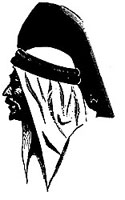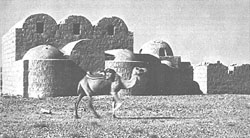Chapter 4 |
 |
|
Of the three great monotheistic religions of the seed of Abraham, it is Islam which is least understood by the West. To better understand the Arabs as a whole people, we must first know something about the code of ethics that once bound three quarters of the known world in religious fervor and civic law, a bonding accomplished within less than a century-and-a-half. As the world is divided today between East and West, so it was in the early centuries. When the Western Empire collapsed in A.D. 475, it was left to Byzantium to support the cause of Europe against Asian Persia. A constant struggle for supremacy between the two powers created a frontier that ran from the Upper Euphrates to the Caucasus, placing the Arabs on the South in contact with both of the Great Empires. Following a desperate war of twenty-six years between these two powers which ended in A.D. 628, both states were devastated and bankrupt. This created the climate for the emergence of the Empire of the Arabs. The Prophet Muhamed had been born in A.D. 570 in Mecca, a town which thrived on the trade caravans from India to the Mediterranean. It is alleged that at the age of forty, in 610 A.D., he saw the Archangle Gabriel in a vision and three years later he received an order to preach. Muhamed, known as a gentle man, did not preach a new religion but claimed
that the true faith was that which had been practiced by the Patriarch Abraham. He proclaimed that there was only one God and set about to convert pagan Arabia to this truth. Muhamed concentrated his preaching on a small building in Mecca called the Kaaba, which housed three hundred sixty-five idols and was the place of worship for the townspeople. Denouncing the idols and idolaters, Muhamed determinedly preached the existence of the one God who would one day come to judge the world. For ten years, he attempted to turn the Meccans from their pagan ways, and, for his efforts, managed to get, in all that time, only sixty or seventy converts. However, Muhamed did succeed in becoming a source of embarassment to the townspeople, since the Kaaba brought them revenue from the caravan tradesmen who left gifts of money to their favorite idols in return for good fortune. Ordered to cease his foolish prattling about one God, and threatened with physical harm if he did not, Muhamed finally gave up his efforts in Mecca, and fled to Medina, a rival city. Here he found the inhabitants not only more receptive to his teachings but also willing to go out and make converts by conquest if necessary. Between 622 and 630, numerous battles were fought between the followers of Muhamed, the Muslims, and other factions and tribes in the deserts and surrounding towns. Finally, in 630, Muhamed marched on Mecca, his native city, at the head of ten thousand followers.
The city was occupied without opposition, its leaders converted, and the Kaaba cleansed of its idols. Muhamed announced that this building was the House of God, and would remain a sacred shrine for all Muslims.15 Mecca increased in fame and prospered with the triumph of Islam. Muhamed, becoming the greatest power in Arabia, moved his seat of authority to Medina where delegates from the Peninsula promised allegiance to the new faith and law. Enforcing the disciplines of the new religion, Muhamed drew his followers into a government, where there had been none before. He forbade them to make war on each other, proclaiming their duty was to fight only the heathen. Muhamed�s friend and successor, Abu-Bekr, a frail old man who accepted the leadership after Muhamed�s death, succeeded in conquering all opposition in Arabia, subduing the most warlike of the tribes and stamping out revolution and resistance in Bahrain, Oman, and the Yemen. When there were no longer non-Muslims to subdue in Arabia, it became inevitable that the martial spirit of the tribes would then turn toward the conquest of their non-Arab, non-Muslim neighbors. Since the Byzantine-Persian Wars had exhausted these two powers, and with Persia in civil war and chaos after the massacre of its ruling family, the Sassanid, the Arabs were able to attack the Persian Frontier with impunity. While one army was massing on the Persian border, another was preparing to meet the Byzantines in Syria. On August 20, 636, the Battle of the Yarmouk resulted in the annihilation of the Byzantine Army. The Arabs re-occupied the whole of Syria and the Emperor Heraclitus abandoned Syria and Palestine forever.
In March, 637, a pitched battle at Quadasiya on the Euphrates, fought by the Arabs under Saad ibn Abi Waqqas against the Persians, gave complete victory to the Arabs, and a year later the conquest of Medain, the capital of the Persian Empire, brought the whole valley of the Tigris and Euphrates again under Arab control. The Roman Power, which had been based on the naval command of the Mediterranean had continued under Byzantium following the collapse of the Western Roman Empire. While the Arabs had conquered Palestine and Syria on land, the Byzantine fleet continued to cruise the Mediterranean from its bases at Alexandria and Cyprus. At the beginning of December, 639, thirty-five hundred Arabs crossed the Egyptian border at Al Arish and set off westward toward the Sinai. It would appear insane that thirty-five hundred Bedouins, an under-equipped army of nomads, would attack a country as wealthy as Egypt was at that time, with its rich and walled cities, its granaries and strong Byzantine garrisons. But these thirty-five hundred formed a vanguard for an additional twelve thousand men who followed. By the end of six months, Heliopolis, a suburb of Cairo today, had fallen and Cyrus, the Orthodox Patriarch at Alexandria, surrendered Egypt to the Arabs who finally occupied Alexandria in 642. From 644 to 656, the Arabs carried their arms and their new religion to Tripoli in North Africa, and had reached the snow covered barrier of the Caucasus. Persia had thus been occupied to the Indus on the frontiers of ancient India.
The Arabs then captured Cyprus, sailed through the Dardanelles unopposed and laid siege to the city of Constantinople. They conquered Rhodes and sailed the Mediterranean, until Mare Nostrum, the Roman Sea, was their own lake. By 680, the Empire of these warriors from the Arabian Desert included the Persian Gulf, Arabia, North Africa, (El-Maghreb, the Arab West,) Syria and Palestine, (El-Mashraq, the Arab East,) and Egypt and Sudan, (the countries of the Nile.) Invasions gaining ground in Sicily, Portugal and Spain soon opened those countries to Arab occupation. For seven centuries, following the Arab occupation of Spain in 712, that country, like Portugal, Italy, France, Greece, Turkey and the small kingdoms of Europe would bear the mark and influence of the Arab Empire. Arab names like Andalus, Cordoba, Sardinia, Malta, Ceuta, Saragossa, Malaga, Gibralter, Alcazar, Segosia and hundreds of other words would become part of western vocabularies. While there had always been a link between the Nubian kings of antiquity with Egypt, the Arab invasions of the medieval years cemented the ties of Islam and Arabic culture with that of East and West Africa. The Bantu language of Swahili takes its name from the Arabic "sawahil," the people of the Coast, and many Bantu words still retain Arabic roots. The university centers at Fez and Timbuktu were long the seats of learning for scholars of every race, color and religion, and both were also flourishing trade centers. In the fourteenth century, the Arabs obtained gold coins from Abubahari, II, of Mali and circulated them in Europe. This first gold coinage since Roman times began a thriving gold trade that extended from Somalia to Mozambique. The trading throughout Africa continued
heavily until the mid-nineteenth century when autonomous rule was lost in both Africa and some parts of the Middle East through foreign colonization. In religion it is interesting to observe that Islam mixed with the animist rites of Africa and was absorbed in some form into the native religion and culture of the area.
|
